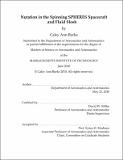| dc.contributor.advisor | David W. Miller. | en_US |
| dc.contributor.author | Burke, Caley Ann | en_US |
| dc.contributor.other | Massachusetts Institute of Technology. Dept. of Aeronautics and Astronautics. | en_US |
| dc.date.accessioned | 2010-10-29T13:49:19Z | |
| dc.date.available | 2010-10-29T13:49:19Z | |
| dc.date.copyright | 2010 | en_US |
| dc.date.issued | 2010 | en_US |
| dc.identifier.uri | http://hdl.handle.net/1721.1/59553 | |
| dc.description | Thesis (S.M.)--Massachusetts Institute of Technology, Dept. of Aeronautics and Astronautics, 2010. | en_US |
| dc.description | This electronic version was submitted by the student author. The certified thesis is available in the Institute Archives and Special Collections. | en_US |
| dc.description | Cataloged from student submitted PDF version of thesis. | en_US |
| dc.description | Includes bibliographical references (p. 103-106). | en_US |
| dc.description.abstract | Spacecraft today are often spin-stabilized during a portion their launch or mission. Though the basics of spin stabilization are well understood, there remains uncertainty in predicting the likelihood of rapid nutation growth due to onboard liquids. Solely analytical methods of prediction are mainly unsuccessful and physical tests to gather slosh data have only been done for a few specific spacecraft. Data from past spacecraft is subject to a number complex physical factors and anomalies during the launch or mission. This study verifies a ground based method to test fluid tanks horizontally and obtain the first fundamental frequency of the tank. Horizontal tanks have the gravitational acceleration vector applied in the same direction as the acceleration experienced by an offset tank on a spinning spacecraft. The study also performs tests on the Synchronized Position-Hold, Engage, Reorient Experimental Satellites (SPHERES) satellites to characterize their nutation. In the tests, the satellite is spun about a single axis and then allowed to drift. Each principal axis is tested by at least one test. Two configurations of the satellite are tested: the satellite by itself and the satellite with an additional rigid mass attached to alter the inertia matrix of the system. These two efforts can be combined in the future to perform spinning slosh testing on the SPHERES satellites, with knowledge of the frequency of the fluid tanks. The potential for the SPHERES Testbed to add to the generic fluid slosh data is due to it having a relatively simple spacecraft system capable of both software and hardware modifications and being located in the visually observable microgravity environment of the International Space Station (ISS). | en_US |
| dc.description.statementofresponsibility | by Caley Ann Burke. | en_US |
| dc.format.extent | 106 p. | en_US |
| dc.language.iso | eng | en_US |
| dc.publisher | Massachusetts Institute of Technology | en_US |
| dc.rights | M.I.T. theses are protected by
copyright. They may be viewed from this source for any purpose, but
reproduction or distribution in any format is prohibited without written
permission. See provided URL for inquiries about permission. | en_US |
| dc.rights.uri | http://dspace.mit.edu/handle/1721.1/7582 | en_US |
| dc.subject | Aeronautics and Astronautics. | en_US |
| dc.title | Nutation in the spinning SPHERES spacecraft and fluid slosh | en_US |
| dc.title.alternative | Nutation in the spinning Synchronized Position-Hold, Engage, Reorient Experimental Satellites spacecraft and fluid slosh | en_US |
| dc.type | Thesis | en_US |
| dc.description.degree | S.M. | en_US |
| dc.contributor.department | Massachusetts Institute of Technology. Department of Aeronautics and Astronautics | |
| dc.identifier.oclc | 668108762 | en_US |
